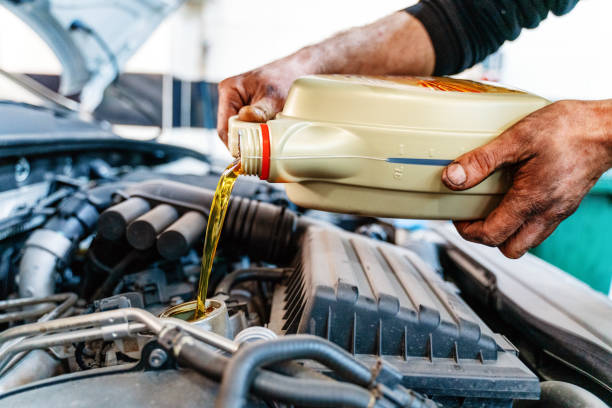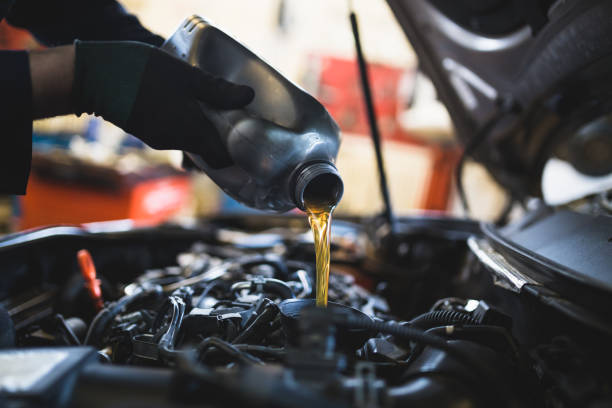That depends on the engine in your car, obviously. Although some small four-cylinder engines may require closer to four quarts, most engines will require between five and six quarts. The maximum amount that larger engines can accept is eight or nine quarts.
Although the amount of oil in your engine doesn’t have to be precise to the last drop, it does matter for a number of reasons. And while determining the proper oil type may only require a quick glance at the oil filler cap, determining the proper capacity might take a little more time.
Why is Oil Important?
Let’s first examine the precise reasons why oil is crucial for your car. Many moving components, such as those found in car engines, can generate heat and friction. Simply by absorbing heat and lubricating the engine, oil keeps a car’s engine from overheating and allowing it to function properly.
However, oil still needs to be maintained. You won’t put it in your car once and never have to do it again for the duration of the vehicle. Oil is no exception; it needs to be changed regularly to keep your car operating smoothly.
Oil loses the thickness that initially helped to make it so effective as it starts to degrade over time. As a result, it is no longer capable of carrying out its duties as effectively as it did before being added to the vehicle. Get in the habit of regularly checking the level of oil in your car because of this. In the end, this can only be avoided by changing the oil in the car at the proper intervals. This makes it easier to guarantee that the oil is pure, effective and performing its function to the highest level. The kind of oil your car uses can also affect how often the oil needs to be changed.
What Are the Different Types of Oils?
There are numerous varieties of oil, and what works for one car might not necessarily work for another. So, if you’re doing it yourself, make sure you check that you’re using the right kind of oil.
Conventional Oil
This kind of oil is petroleum-based and produced using crude oil that is mined underground. Price-wise, it is typically less expensive than other types of oil, but it is also more temperature-sensitive. Additionally, it is known to thin in the heat and thicken in cold temperatures. The tendency of this kind of oil to produce sludge is also due to the thickening of contaminants, oils, and carbons.
Synthetic Blend Oil
As you might have guessed, this kind of oil is a blend. It is both conventional and synthetic, enhancing performance and lubrication while safeguarding internal components in your car.
Because they don’t degrade as quickly as traditional oils do, these oils typically last longer. They are better at withstanding heat, which is another thing to note. While a synthetic blend oil won’t be as inexpensive as conventional oil, you still get a lot for your money and won’t be paying as much as you would for a fully synthetic oil.
High-Mileage Synthetic Blend
Next is the synthetic blend oil for high mileage. This oil might be suitable for your vehicle if it has accumulated at least 75,000 miles. You should start taking extra precautions once your car reaches this mark. Switching to this kind of oil is one of these safety measures. In addition to having better additives and detergents, it has all the advantages of synthetic blend oils.
This shields the car from incredibly high heat, wear, and sludge buildup. The main benefit of the additives is that they increase the engine’s lifespan. Seals, piston rings, and other things are all protected by them. To stop the oil from deteriorating due to oxidation, antioxidants have also been added.
Finally, detergents are included to keep your engine clean and remove sludge. This is a fantastic alternative because they cost less than full synthetic oils while lasting longer than regular petroleum oils would. It’s a win-win.
Full Synthetic Oil
Let’s talk about full synthetic oil since we’ve already mentioned it a lot. Full synthetic oil is essentially crude oil that has been refined and disassembled into simple molecules. These are created to satisfy the demands of vehicle engines. Furthermore, this kind of oil contains additives that were produced synthetically. These are more expensive than conventional oils when compared, but because of the structure of their molecules, they also lubricate and clean out impurities better and last longer. Additionally, this kind of oil is more heat-resistant than others, doesn’t accumulate sludge easily, and is generally less sensitive to temperature changes. The amount of full synthetic oil the engine needs to use is therefore reduced.
European Oils
European oil is not the least, though. While this kind of oil shares many characteristics with fully synthetic oils, it also contains unique additives. This is intended for stricter emissions. For this reason, a high-end, European-made vehicle typically uses European oil. The most expensive oil is this kind.

WAYS to FIND HOW MUCH OIL the Car Need
Check the Owner’s Manual
Your car’s owner’s manual should be your first stop. There, it usually specifies the kind of oil you require, the required viscosity or thickness, the frequency of replacement, and the required quantity. If you can’t find your owner’s manual, you can browse the manual library on the website of your manufacturer. To get it, you may occasionally need to register on the website or enter your vehicle’s VIN.
Checking Product Manual
The product manual is the next item you should examine. You can learn a lot from the product about what kind of oil is best for your car. Motor oil is a multi-grade oil because it typically displays two numbers. The thickness or viscosity at lower temperatures is indicated by the first number. If it’s lower, colder weather doesn’t affect oil’s ability to move.
The second number represents the oil’s performance at higher temperatures. Oils may thin out as the temperature rises. Finding oil that can still properly lubricate your engine in warm climates is therefore essential.
You can estimate how much oil you need by knowing the grade of the oil and using that information along with the instructions in your owner’s manual, especially if you live in a particular climate.
Call a Pro
Call the parts department at your neighborhood dealer. Year, make, model and engine size are possible inquiries. Or, more likely, they’ll ask for your VIN, which is a more dependable way for them to locate the information you require. Check out our quick guide to communicating with a mechanic if you’re unsure of where to find your VIN.
Use Online Resources
Using tools like the Advance Auto Parts website can be a great resource if you prefer to handle things on your own. Here’s how you can find your vehicle’s oil capacity using the Add a Vehicle tool from Advance:
STEP 1. ENTER YOUR VEHICLE INFORMATION
Visit the Advance Auto Parts website and use the Add a Vehicle tool to enter the details of your vehicle. You can conduct a search using the VIN, license plate, or the year, make, and model. Remember that if there are multiple engine options for your vehicle, you’ll also need to know which one it has if you search by year, make, and model.
STEP 2. READ FITMENT DETAILS
Look at the specifics of the green Exact Fit message in the search results after conducting a search for motor oil. For the majority of vehicles, fitting information including oil type, viscosity, and capacity is provided.
It only takes two simple steps.
Keep in mind that the quantity includes a filter change. Even though we advise replacing your oil filter every time you change your oil, your engine will still require less oil if you don’t. Fortunately, it’s a simple task, and we can help you with it.
It’s crucial to measure the level after adding oil. If you want to do that, shut off the engine and secure the oil filler cap. Pull the dipstick and clean it after letting the oil settle for a few seconds. Insert it fully and pull it again, this time checking to confirm the level is at the “full” mark on the dipstick. If the level is low, you can typically assume that there is 1 quart or less between the lines before topping off with some accuracy.
Factors That Determine the Amount of Oil Needed by Your Car
The Size of the Engine
Approximately five quarts of engine oil are required for a car engine, as was previously mentioned. However, the quantity is determined by the size of the engine, i.e., larger engines need more than smaller-sized ones.
- 5 quarts of engine oil works with a four-cylinder engine
- Consider using about 6 quarts of oil if your car has a six-cylinder engine.
- Models with eight cylinders typically use 5 to 8 quarts. The precise sum, however, is determined by the engine’s displacement.
The quantity may occasionally be influenced by particular actions, such as changing an oil filter, particularly when changing the oil.
Oil Filter Change
Prepared to replace your car’s outdated oil filter? If so, you must replace the current oil with a new supply because the old oil might be contaminated with dirt and other impurities. Additionally, changing the filter will reveal how much engine oil is required for the vehicle.
Consider changing the filter on a V6 engine. You should be prepared to use about 4 quarts of motor oil. You will, however, use less of it if you refuse to touch the object.
Why is there a difference between the two? Because some oil remains in the oil filter, if you don’t install a new filter, the old and new engine oils will mix.
How Often Should I Change My Car’s Oil?
How often you should change your car’s engine oil depends on a few different factors. These factors include the age of the car, the kind of oil it uses, and the kinds of driving situations you usually use your car in.
While changing your car’s oil every 3,000 miles used to be standard practice, modern lubricants have altered this. Nowadays, most engines need an oil change every 5,000 to 7,500 miles. Nevertheless, how frequently you change your car’s oil can vary depending on the type of oil it needs.
With full-synthetic motor oil, for instance, you might be able to go up to 15,000 miles between services. It’s also crucial to remember that you can’t determine the condition of your engine oil by looking at its color, so you should stick to the maintenance schedule recommended in your owner’s manual. The vehicle’s age must also be considered.
Older cars need to have their oil changed at specific intervals determined by their mileage. In addition to this, if you operate your vehicle in “severe” situations, such as primarily brief trips (5 miles or under), in extremely hot or dusty climates, in sustained stop-and-go driving conditions, or while carrying heavy loads, you should follow a more rigorous schedule. The owner’s manual will have specifics on this. For newer vehicles, the instrument panel frequently displays a warning. If you are unable to locate that, you should adhere to the instructions in the owner’s manual.

What Happens If My Oil Level is Too Low?
Oil serves a variety of functions, so it’s not good. We all are aware that it lubricates engine components. Oil also helps the engine run more smoothly by reducing friction. It’s a lesser-known fact that oil contributes to engine cooling, which is one of its lesser-known uses. For each of these areas to operate at its best, the right amount of oil must be present.
Remember that startup is the most crucial time for any engine, even though most cars can go for a short while with one quart of oil low without suffering any serious consequences. The upper-end parts (cam, cam bearings, lifters, valves, and timing chain) must receive motor oil within the first few seconds of starting the engine. These vital components won’t receive enough oil quickly if the crankcase’s oil volume is too low.
What Happens If My Oil Level is Too High?
Not good, the crankshaft and oil pump have a tendency to aerate and whip the oil into a froth if there is too much motor oil in the crankcase. Almost all of the engine’s moving parts become one large oil pump as a result of this, and the oil pump’s intake will also be picking up a lot of air in addition to the oil. Keep in mind that the crankshaft and other components will be turning at about 20 times per second at highway speeds, which will cause the oil to be very agitated. Serious engine wear may result from frothy, bubbly motor oil’s inability to effectively lubricate bearings and cylinder walls.
If you’ve still got doubts about how much motor oil your engine needs, make sure that the oil level on the dipstick is between “add one qt” and “full,” and you should be fine!
Summary: Depend On Your Car’s Engine
For your car to be properly maintained, you must make sure it has the appropriate level of oil. In light of this, it’s crucial to check that your car is using the right kind of oil. Your car will likely last a long time if you keep an eye on both of these things.



